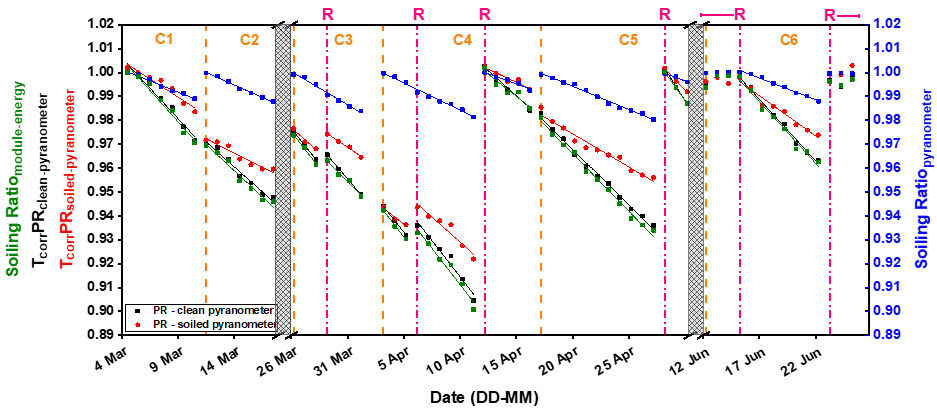


Accurate solar irradiance measurement is crucial for evaluating photovoltaic (PV) system performance. While PV module soiling is well studied, the impact of soiling on pyranometers, sensors used to measure irradiance, has received limited attention. Pyranometer soiling can have a serious impact on the accuracy of performance ratio (PR) calculations, which are widely used for PV system diagnostics, energy yield assessments, and maintenance scheduling. To investigate this, a field study was conducted at the Photovoltaic Module Monitoring Station (PVMMS), IIT Bombay, by Pavan Fuke, a PhD student at NCPRE, under the guidance of Prof. Anil Kottantharayil. The setup included two thermopile pyranometers and two 100 Wp polycrystalline PV modules, all mounted at a latitude angle of 19°. One pyranometer was cleaned daily, while the other was cleaned at varying intervals according to IEC and ASTM standards, as well as the guidelines provided in the pyranometer datasheets, over a period of three summer months. Irradiance, module output, and backsheet temperature were recorded at one-minute intervals using a high-precision I-V curve tracer, and used to compute the temperature-corrected PR (TcorrPR). Pyranometer soiling rates were found to range between 0.19% and 0.29% per day, only 36% to 48% of the PV module soiling rates (see Figure). This caused a 30% to 43% underestimation of module soiling rate based on TcorrPR when using soiled pyranometer data, significantly delaying optimal cleaning decisions. In utility-scale PV plants, such delays have a major economic impact. For instance, in a 100 MW plant, a 6-day delay in cleaning caused by inaccurate PR readings due to pyranometer soiling led to 1,50,000 kWh of energy loss and ₹4.5 lakh in lost revenue; a 14-day delay caused losses of ₹21 lakh. To address this, the study proposed using a 1% daily irradiance uncertainty threshold, aligned with pyranometer datasheets and industry standards, to determine optimal cleaning intervals. This method suggested a 3 to 4 day cleaning cycle for Mumbai. Furthermore, cleaning recommendations were generated for 103 global sites, accounting for local soiling rates and climate.
The study also observed that errors in TcorrPR caused by pyranometer soiling were lowest during early morning and late afternoon. This indicates that evaluating PR during these hours can mitigate soiling-related inaccuracies when frequent cleaning is not feasible. Overall, the work presents a robust and scalable framework to improve PR accuracy and optimize cleaning strategies for PV systems. It offers practical tools to minimize performance loss and reduce maintenance costs for solar plant operators. The manuscript has been accepted for publication in Solar Energy, a reputed journal in the PV field with an impact factor of 6.

Soiling ratio of the pyranometer and PV module and TcorrPR using the clean and soiled pyranometer data for all six cycles. An orange vertical dash line separates each cycle interval and also denotes the 1st day of the cycle, and the pink vertical dash-dot line represents the rain event R. The grey boxes are the days with no data.